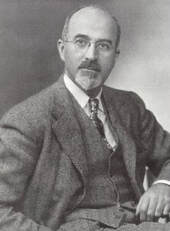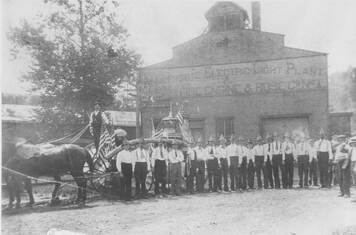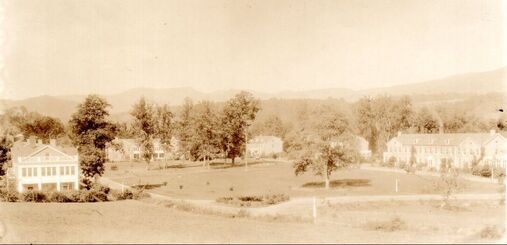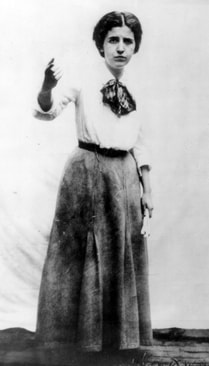Early Queer History of the Greenbrier ValleyBy Sarah Shepherd - Archive Associate “Of course, sex has been all things in all periods…But on the whole, the farm enjoyed sex more, respected it more, and discussed it less…Sex was like groceries…most of the people stored their supplies at home. And county eating is lush and good. I have never understood this much-bruited Puritanism. We were Presbyterians of the deepest dye, running to clergymen and elders and tenders of out-post Sunday Schools. But I do not recall any adults who worried about their immortal souls (the Lord would tend to that) nor about their sexuality; the Lord had already tended to that.” |
| The focus on sodomy meant that women were not arrested as much as men. However, Elizabeth Gurley Flynn, a political radical who was sentenced to two years in the Alderson Federal Women’s Prison in 1951, described lesbianism in the prison in her memoir. She described how “the women walked two-by-two, as directed by the officer. But they chose their own partners and woe betide anyone who tried to cut in on an unmistakable lesbian pair… |
| In the dark of the movies these pairs held hands and kissed passionately, and walking home hung behind the lines, behaving in a lover-like fashion.”[18] While some of these relationships were temporary, other women exchanged rings and called each other husband and wife.[19] Flynn described one woman who grew up in Alderson and both her and her sister were lesbians. She was in a relationship with another woman. Her lover broke it off when she fell in love with a man, but he deserted her when she became pregnant. The two women resumed their relationship and raised the child together. The mother eventually married someone else when their son was five, but the boy kept in touch with his other mother.[20] |
 Walter Freeman
Walter Freeman Prison in the early 1900s were harsh and some men chose the mental institution instead. Bill Richards, a Charleston florist, chose the mental institution, despite knowing that he was not crazy for being gay, and was locked up in maximum security for several months in the late 1960s.[21] The institution was not safer. Homosexuality was considered a medical disorder and doctors would apply electric shock therapy and even perform lobotomies to try to cure people. Walter Freeman, who invented the ice pick lobotomy, operated in West Virginia. The Smithsonian Magazine recorded that around forty percent of the thousands of lobotomies that Freeman performed were on queer people.[22] These operations had varying consequences including death and severe disfunction.
In Greenbrier County, there were five known convictions of sodomy. Five men were convicted from 1950 to 1963 with their names and crime posted in the public newspaper, the Greenbrier Independent.[23] At this time, the Greenbrier Independent’s motto was “Nothing Shall be Indifferent to Us Which Advances the Cause of Truth and Morality or Which Concerns the Welfare of the Community in Which We Live.”[24] These men were forcibly outed to their community as all indictments were listed on the front page. West Virginia did not repeal its sodomy law until 1976.[25]
In Greenbrier County, there were five known convictions of sodomy. Five men were convicted from 1950 to 1963 with their names and crime posted in the public newspaper, the Greenbrier Independent.[23] At this time, the Greenbrier Independent’s motto was “Nothing Shall be Indifferent to Us Which Advances the Cause of Truth and Morality or Which Concerns the Welfare of the Community in Which We Live.”[24] These men were forcibly outed to their community as all indictments were listed on the front page. West Virginia did not repeal its sodomy law until 1976.[25]
Other Literature on Appalachian and West Virginian Queer History
| Rebecca Baird, Kathryn Staley, and Jeff Mann, “Mountaineer Queer: An Interview with Jeff Mann,” Appalachian Journal, Vol 35. No 1/2 Fall 2007/Winter 2008 Kate Black and Marc A. Rhorer, “Out in the Mountains: Exploring Lesbian and Gay Lives,” Journal of Appalachian Studies Association Vol 7. 1995 Jeff Mann “Stonewall and Matewan: Some Thoughts on Gay Life in Appalachia” in Journal of Appalachian Studies, Vol. 5, No. 2, Fall 1999 Edge: Travels of an Appalachian Leather Bear, Harrington Park Press, 2003 Loving Mountains, Loving Men, Ohio University Press, 2005 “The Mountaineer Queer Ponders His Risk-list,” Appalachian Journal, Vol. 34, No. 3/4 Springs/Summer 2007 Binding the God: Ursine Essays from the Mountain South, Bear Bones Books, 2010 | “Risk, Religion, and Invisibility,” Journal of Appalachian Studies, Vol. 20, No. 2, Fall 2014 Silas House, “Our Secret Places in the Waiting World: or, A Conscious Heart, Continued,” Journal of Appalachian Studies, Vol. 20, No. 2, Fall 2014 Carrie Nobel Kline, Revelations, Huntington, West Virginia, 2001. This was a theatrical presentation about Appalachian resiliency in lesbian, gay, bisexual and transgendered people written and produced by folklorist Carrie Nobel Kline. Read more about the project: https://www.folktalk.org/spoken-histories/glbt-stories/ Her collection of interviews of queer West Virginians are at Marshall University. Bradley Milam, Gay West Virginia: Community Formation and the Forging of a Gay Appalachian Identity, 1963-1979, Dissertation at Yale University, April 2010. |
References
[1] 1880 U.S. Census, Fort Spring, West Virginia, population schedule, p.23, dwelling 185, family 205, Mae Best, digital image, http://ancestry.com.
[2] Doug Hylton, “Ronceverte’s story connected with transgendered citizen,” Mountain Messenger, January 23, 2016.
[3] New York, New York, U.S., Extracted Marriage Index, 1866-1937, Maynard Best to Bryna Stacking Hunthall, June 30, 1906, http://ancestry.com.
[4] 1910 U.S. Census, Los Angeles, California, population schedule, p.1, dwelling 18, family 19, Maynard H. Best, digital image, http://ancestry.com.
[5] California, U.S., Death Index, 1905-1939, Dollie Best, death January 1, 1935, http://ancestry.com.
[6] “Fire at Cass,” Pocahontas Times, February 25, 1915.
[7] “Circuit Court,” Pocahontas Times, April 15, 1915.
[8] “The Strange Case of Max Curry,” Pocahontas Times, April 22, 1915.
[9] Marriage of Lillian L. Nethercutt and M. M. Curry, 1909, Vital Research Records-Marriage, West Virginia Department of Arts, Culture, and History, http://www.wvculture.org/vrr/va_mcdetail.aspx?Id=11100236.
[10] “The Strange Case of Max Curry,” Pocahontas Times, April 22, 1915.
[11] Ibid.
[12] Pocahontas Times, June 24, 1915.
[13] Pocahontas Times, August 5, 1915.
[14] Ibid.
[15] West Virginia, U.S., Wills and Probate Records, 1724-1985, Max Curry, probate date October 11, 1919.
[16] 1920 U.S. Census, Huntington, West Virginia, population schedule, p.14, dwelling 265, family 287, Lillian Curry, digital image, http://ancestry.com.
[17] Interview with Richard Weikel, conducted by Roland Layton, October 30, 2002, transcript pg. 7-8.
[18] Elizabeth Gurley Flynn, The Alderson Story: My Life as a Political Prisoner, (New York: International Publishers, 1963), 159.
[19] Ibid., 160.
[20] Ibid., 160-161.
[21] Trey Kay, “Us & Them: Locked up for Sodomy,” West Virginia Public Broadcasting, October 15, 2015, https://www.wvpublic.org/podcast/us-them/2015-10-15/us-them-locked-up-for-sodomy.
[22] “What it was like to be Gay during WWII,” Smithsonian Magazine, https://www.smithsonianmag.com/videos/category/history/what-it-was-like-to-be-gay-during-wwii/.
[23] “Circuit Court,” Greenbrier Independent, April 27, 1950; “Indictments Made,” Greenbrier Independent, April 28, 1955; “Grand Jury Indictments,” Greenbrier Independent, April 30, 1959; “Sentences Given,” Greenbrier Independent, May 15, 1958; “Circuit Court Indictments,” Greenbrier Independent, November 14, 1963; “Circuit Court Notes,” Greenbrier Independent, November 21, 1957.
[24] Greenbrier Independent, November 14, 1963.
[25] George Painter, “The Sensibilities of Our Forefathers: The History of Sodomy Laws in the United States,” Gay & Lesbian Archives of the Pacific Northwest, https://www.glapn.org/sodomylaws/sensibilities/west_virginia.htm#fn9.
[2] Doug Hylton, “Ronceverte’s story connected with transgendered citizen,” Mountain Messenger, January 23, 2016.
[3] New York, New York, U.S., Extracted Marriage Index, 1866-1937, Maynard Best to Bryna Stacking Hunthall, June 30, 1906, http://ancestry.com.
[4] 1910 U.S. Census, Los Angeles, California, population schedule, p.1, dwelling 18, family 19, Maynard H. Best, digital image, http://ancestry.com.
[5] California, U.S., Death Index, 1905-1939, Dollie Best, death January 1, 1935, http://ancestry.com.
[6] “Fire at Cass,” Pocahontas Times, February 25, 1915.
[7] “Circuit Court,” Pocahontas Times, April 15, 1915.
[8] “The Strange Case of Max Curry,” Pocahontas Times, April 22, 1915.
[9] Marriage of Lillian L. Nethercutt and M. M. Curry, 1909, Vital Research Records-Marriage, West Virginia Department of Arts, Culture, and History, http://www.wvculture.org/vrr/va_mcdetail.aspx?Id=11100236.
[10] “The Strange Case of Max Curry,” Pocahontas Times, April 22, 1915.
[11] Ibid.
[12] Pocahontas Times, June 24, 1915.
[13] Pocahontas Times, August 5, 1915.
[14] Ibid.
[15] West Virginia, U.S., Wills and Probate Records, 1724-1985, Max Curry, probate date October 11, 1919.
[16] 1920 U.S. Census, Huntington, West Virginia, population schedule, p.14, dwelling 265, family 287, Lillian Curry, digital image, http://ancestry.com.
[17] Interview with Richard Weikel, conducted by Roland Layton, October 30, 2002, transcript pg. 7-8.
[18] Elizabeth Gurley Flynn, The Alderson Story: My Life as a Political Prisoner, (New York: International Publishers, 1963), 159.
[19] Ibid., 160.
[20] Ibid., 160-161.
[21] Trey Kay, “Us & Them: Locked up for Sodomy,” West Virginia Public Broadcasting, October 15, 2015, https://www.wvpublic.org/podcast/us-them/2015-10-15/us-them-locked-up-for-sodomy.
[22] “What it was like to be Gay during WWII,” Smithsonian Magazine, https://www.smithsonianmag.com/videos/category/history/what-it-was-like-to-be-gay-during-wwii/.
[23] “Circuit Court,” Greenbrier Independent, April 27, 1950; “Indictments Made,” Greenbrier Independent, April 28, 1955; “Grand Jury Indictments,” Greenbrier Independent, April 30, 1959; “Sentences Given,” Greenbrier Independent, May 15, 1958; “Circuit Court Indictments,” Greenbrier Independent, November 14, 1963; “Circuit Court Notes,” Greenbrier Independent, November 21, 1957.
[24] Greenbrier Independent, November 14, 1963.
[25] George Painter, “The Sensibilities of Our Forefathers: The History of Sodomy Laws in the United States,” Gay & Lesbian Archives of the Pacific Northwest, https://www.glapn.org/sodomylaws/sensibilities/west_virginia.htm#fn9.
8 Comments



 RSS Feed
RSS Feed
